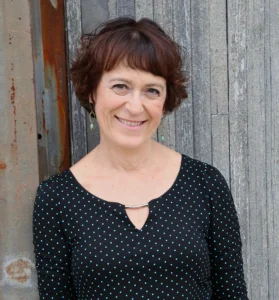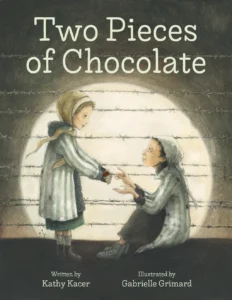Kathy Kacer’s new book TWO PIECES OF CHOCOLATE (Second Story Press, 2024), illustrated by Gabrielle Grimard, is based on the true story of a young girl named Francine and her mother, who help a pregnant woman find a bit of hope in the darkest of times. Set in the Bergen-Belsen concentration camp, Kathy’s heartachingly beautiful story underscores the spirit of humanity. Kathy’s many books about the Holocaust are so vital, and TWO PIECES OF CHOCOLATE will be an important addition to libraries and personal collections for a new generation of readers.
Welcome back, Kathy!
TWO PIECES OF CHOCOLATE, set in the Bergen-Belsen concentration camp, is based on a true story about Francine and her mother, who share their precious chocolates with Hélène, a young pregnant woman. How did you first discover this story?
This story was actually a “gift” to me from my publisher, Margie Wolfe of Second Story Press. Margie told me the story of Francine Christophe and her two pieces of chocolate. I’m not even sure how Margie stumbled across the story. But as soon as I heard it, I knew that this was a story that I wanted to write.

You have written many stories for young readers about the Holocaust. As a writer, how do you balance the seriousness of the topic with the age level of your readers?
I’ve written so many books about the Holocaust for young readers that I’m not even sure any more how I tread that line between being truthful about this difficult history and remaining sensitive to the age and stage of development of my readership. I always joke that I have a “Holocaust radar” that goes off if I’ve gone too far in my descriptions, or if I am being too graphic. I often think back to how my own parents were able to talk to me about their survival experiences in a way that didn’t terrify me, but rather made me more curious and passionate about this history. Perhaps I learned how to write these stories from them. And certainly, I’ve learned a lot from the kids I’ve written for – what they can absorb, how much is too much, how to engage them in this history, etc. I always say that it is okay for kids to be moved or even saddened by this history; it’s a sad history! What I don’t want is for kids to be traumatized by this history. And I think I achieve that balance in the writing that I do.

What were your thoughts when you saw Gabrielle Grimard’s illustrations?
Oh, I love Gabrielle’s illustrations! I have been an admirer of hers for some time. When her name came up as a possible illustrator, I held my breath, hoping she would take this on. And I was thrilled when she did. Reviewers have said that Gabrielle’s drawings are filled with expressions of sadness, kindness and awe. I couldn’t agree more.
Are there any anecdotes or interesting facts about Francine that did not make it into the book?
Since this is a picture book, I really had to condense Francine’s long life into a very brief period of time. I wrote so little about her childhood, or about her life after the Holocaust. I probably could have written a whole novel about Francine. But I chose instead to focus on a moment in time – the time when she shared her two pieces of chocolate with a fellow prisoner in Bergen Belsen.
Your author’s note offers an emotional conclusion when Francine is reunited with the baby she helped save. In your many years of researching the Holocaust, have you learned of other unexpected connections like this one?
There are so many stories of Holocaust survivors who have unexpectedly discovered someone or something from their past. I’ll give you just one example. I am currently completing an adaption of an adult memoir that was written by a Holocaust survivor named Max Eisen. The book will be called By Chance Alone: The Young Readers Edition and will be out in September 2024. Max was liberated in 1945 by African American soldiers who were members of the 761st Tank Battalion. Years later, while accompanying a group to Poland on the March of the Living, Max met a man who had been one of the African American soldiers who had liberated him so many years before that. It was a chance meeting but the two remained friends for many years after that. Those moments of serendipity are always quite remarkable.
What do you hope young readers take away from Hélène’s story?
As always, I hope this is an opportunity for readers to learn one more personal story from the Holocaust. There are millions to tell and each one adds to the compendium of stories that are out there – filling out the many complex facets of this time in history. One of the things that I love about this story is that Francine is not only a survivor, but also a protector – someone who demonstrated compassion to a fellow prisoner. Compassion is a buzz word for me these days, and when I talk about this story with young readers, I always encourage them to think about how they can act with compassion in their lives. Small acts of kindness can go a long way!
Thank you, Kathy!
Kathy Kacer’s books have won a number of awards, including the Silver Birch and the Jewish Book Award. A former psychologist, Kathy now travels the globe speaking to children and adults about the importance of keeping the memory of the Holocaust alive. Kathy lives in Toronto with her family.
Thank you @KathyKacer for writing stories that showcase the worst and best of humanity in a way that is appropriate for children. Not an easy task, but an important one.
I agree, Liz. Kathy’s books are so important.